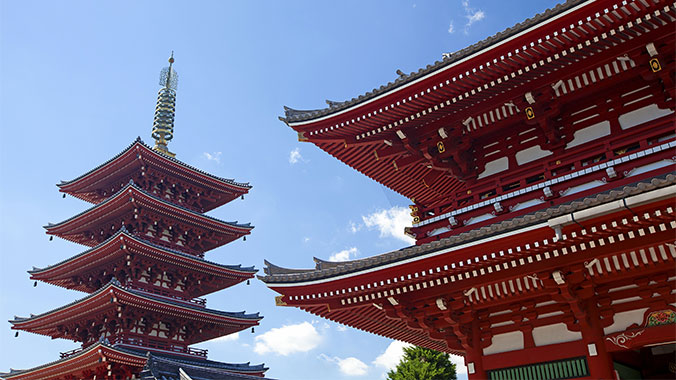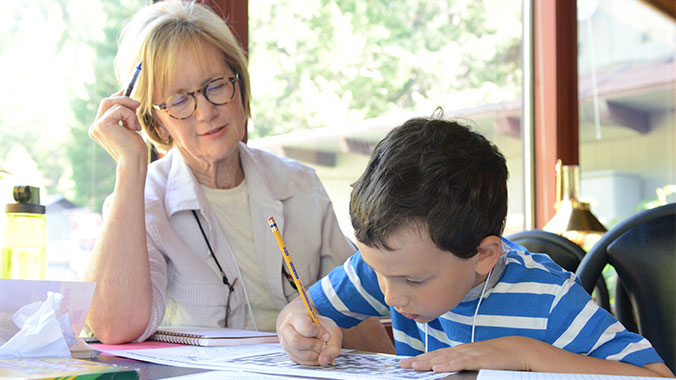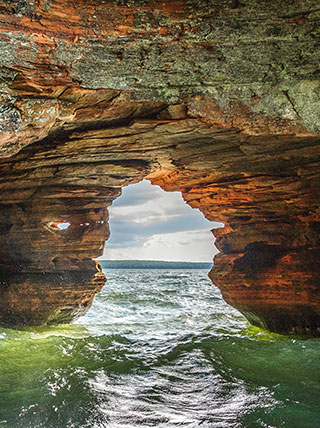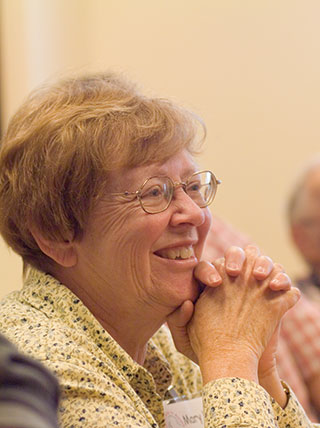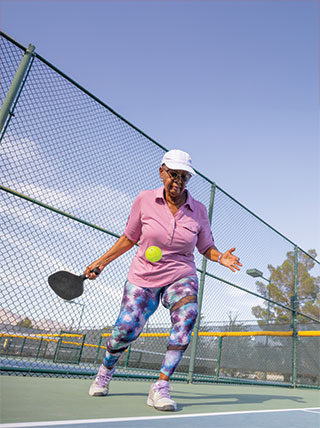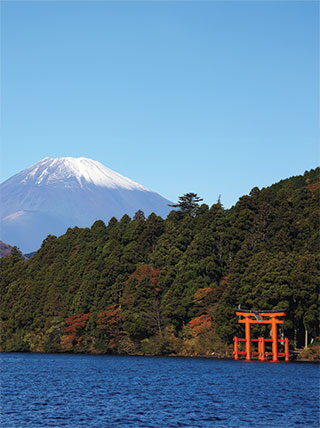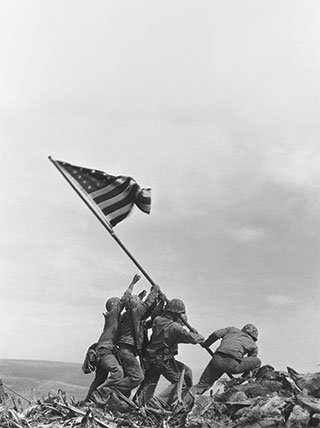Awesome Asia: The Best of Japan With Your Grandchild
Enroll with Confidence
We want your Road Scholar learning adventure to be something to look forward to—not worry about. Learn more
Protecting the Environment
We offset a portion of the emissions created by your travel. Learn more
At a Glance

What You'll Learn
- Stroll through shrines surrounded by forest and venture to temples that are unlike anything you have ever seen, as you learn how important they are to the locals.
- Explore one of the best-preserved castles in Japan and learn how it was built to fend off invaders.
- Get a real taste of Japanese life during a sushi-making class and in a fun manga drawing class.
Activity note: Hotel check-in available from 2:00 p.m.
Afternoon: After checking in to the hotel and getting your room, take some time to freshen up and relax.
Dinner: As many flights from the U.S. are likely to arrive during the evening, this meal has been excluded from the program cost and is on your own to enjoy what you like. The Group Leader will be happy to offer suggestions.
Evening: Continue getting to know your fellow Road Scholars, settle in, and get a good night’s rest for the day ahead. As we will discuss during our Orientation session tomorrow morning, Tokyo is a vast city. To make the most of our experience, we will do as locals do and use the large, complex, public transit subway system. We will provide preloaded debit cards (Pasmo) that will cover all of the included program transportation. This card can be reloaded with additional amounts and can be used for free time in Tokyo and other cities as well. The high-speed Shinkansen “bullet train” we will use to transfer between some cities can reach speeds of nearly 200 miles per hour. We will also take motorcoaches when that makes the most sense.
Activity note: Getting on/off public transit; stairs and escalators. Walking up to 5 miles throughout the day and standing. Shoes may be removed multiple times; possibly sitting on low chairs during demonstration in tatami room.
Breakfast: At the hotel.
Morning: After breakfast we come together in a hotel meeting room for our Orientation. The Group Leader will greet everyone and lead introductions. We will review the schedule and any changes, discuss roles and responsibilities, logistics, safety guidelines, emergency procedures, and answer questions. A number of meals will be on your own to enjoy the cuisine of your choice. The Group Leader will be happy to offer suggestions. Periods in the schedule designated as “free time” and “at leisure” offer opportunities to do what you like and make your experience even more meaningful and memorable according to your personal preferences. The Group Leader and local guides will be happy to offer suggestions. Program activities, schedules, personnel, and indicated distances or times may change due to local circumstances/conditions. In the event of changes, we will alert you as quickly as possible. Thank you for your understanding. After orientation, we will set out and use the metro to head to Asakusa, where residents take pride in being “edokko” — people of Edo, the pre-modern name for Japan.
Lunch: Arriving at the workshop home of a local couple, we will participate in a hands-on sushi-making class. We then dine on what we have just made for lunch.
Afternoon: After lunch we hop into rickshaws and ride through the streets of Asakusa to Sensoji Temple, the city’s oldest and busiest. At Sensoji, we will learn about Buddhism in the daily lives of Japanese people. We have some free time to explore the Asakusa area. Your Group Leader will be happy to offer suggestions. We return to our hotel and have some time at leisure. We then travel to dinner via public transport.
Dinner: We have dinner in a casual Japanese “izakaya” (tavern).
Evening: We return to our hotel at leisure.
Activity note: Getting on/off public transit; stairs and escalators. Walking up to 5 miles throughout the day and standing.
Breakfast: At the hotel.
Morning: We will take public transport to the Meiji Shrine. Dedicated to the late 19th-century emperor Meiji who opened Japan to the West, the shrine is situated in a serene forest oasis. The 40-foot-high torii gate at the entrance is made of 1,500-year-old cypress. A local expert will tell us about the history of the shrine and some basics of Shinto — a belief system unique to Japan. Incidentally, to become a Shinto, you must be Japanese and born in Japan. Next, just steps outside of Meiji Shrine, we will move from tradition and into the ultra-modern in Harajuku, the center of Japanese youth culture and fashion. Here we will be amazed by the sights and sounds as we stroll the narrow, vibrant laneways.
Lunch: At own arrangements.
Afternoon: Free time. The remainder of the day is at leisure. This time has been set aside for personal independent exploration to see and do what interests each of us most. The Group Leader will be happy to offer suggestions. You may wish to walk down Omotesando, the tree-lined “Champs Elysees” of Tokyo. This neighborhood is the location for haute couture brands. Even more impressive than fashion brand names are the stunning, architecturally-ambitious buildings by great modern architects who have been the recipients of more Pritzker Architecture Prizes than anywhere else in the world. Please note that the period scheduled for free time is subject to change depending on local circumstances and opportunities for independent exploration. The Group Leader will accompany those who wish to return to the hotel via public transportation.
Dinner: This meal has been excluded from the program cost and is on your own to enjoy what you like. The Group Leader will be happy to offer suggestions.
Evening: At leisure.
Activity note: Getting on/off public transit; stairs and escalators. Walking up to 5 miles throughout the day and standing.
Breakfast: At the hotel.
Morning: We will board public transport and transfer to Toyosu. Here we will visit teamLab Planets, an art museum where visitors can immerse themselves in the artworks. After time to soak up this intriguing artscape, we will board the Yurikamome — a driverless train system — to travel to Nakano. From our train, we can take in the sights of Odaiba Seaside Park. We will learn something of how the island was constructed on reclaimed land and why it was needed.
Lunch: At a local restaurant.
Afternoon: In Nakano, we have a walking exploration of the neighborhood. We wander through the meandering pedestrian streets where small businesses are jumbled with modern pop culture. We explore Nakano Broadway, a spiritual home to Japan's "otaku" culture. At a local school, we will learn the history of “manga” — a uniquely Japanese art form. We then learn how to draw our own in a hands-on activity. We return to our hotel and have the rest of the afternoon and evening at leisure. Those who wish to do so are welcome to stay out and explore, making their own way back to the hotel independently.
Dinner: On your own to explore local fare and enjoy what you like.
Evening: At leisure. Prepare for check-out and transfer to Misugi in the morning. Prepare to take all luggage to reception by 7:00 a.m. tomorrow morning. Larger luggage will be sent ahead to Kyoto; plan to take smaller luggage with only what you need for the two days in Misugi on the train.
Activity note: Getting on/off a bullet train; riding approximately 1.5 hours. Getting on/off a motorcoach; driving about 90 miles throughout the day, approximately 3 hours total riding time. Walking about 1 mile, standing up to 2 hours at a time; paved and unpaved ground. Shoes must be removed at entrance of Japanese hotel rooms. Sitting on low chairs for dining; sleeping on Japanese futons on floor.
Breakfast: At accommodation.
Morning: After checking out of the hotel, we will take taxis to the train station and catch a shinkansen “bullet train" to Nagoya. Upon arrival at the Nagoya train station, we will board a motorcoach and ride to Mie Prefecture.
Lunch: On your own en route.
Afternoon: We will arrive at a local municipal center and engage in a hands-on activity, learning how to make Iga Kumihimo, braided silk cords combined with silver or gold threads. The craft has a centuries-old history, with skills and designs handed down through many generations. We will make a key ring or bracelet in a choice of colors, to take home. Next we will visit the Ninja Museum of Igaryu. Iga is the center of historical study of ninja. Not just the stuff of action movies, ninja were the secret spy network for shoguns. They employed martial arts, physical prowess, and secret disguises to carry out their missions and evade danger. At the museum, we will learn about their weapons, history, and meet actual ninjas. Even today, their skill is passed on from parent to child, which we will see in a performance of their skills. We will then ride on to Misugi and check in to our “ryokan” (Japanese hotel), with tatami rooms. If you like, you may change into the provided “yukata” (casual kimono).
Dinner: At the hotel.
Evening: At leisure. You might like to use the onsen — the traditional, communal Japanese bath divided into male and female sections. Japanese culture is particular about manners; bath etiquette will be detailed in preparatory materials sent following enrollment. Note: There is still a cultural taboo against tattoos in Japan. People with tattoos are generally not permitted in Japanese communal baths.
Activity note: Getting on/off a motorcoach. Walking in forest.
Breakfast: At the hotel.
Morning: We will ride to the village of Misugi and walk through the town, meet local people, and gain insights into local life. We also learn about the family who owns our hotel, how they grow some of their own produce for use in the restaurant, and even brew their own beer.
Lunch: We will have a typical Japanese camping lunch that we will cook ourselves. We will have some time to explore the local forest as our lunch cooks.
Afternoon: After lunch, we will learn how to make a traditional Japanese cake. We then have some “down time” to explore the resort on our own or enjoy the on-site onsen.
Dinner: In a private tatami room at the hotel, we will have a traditional kaiseki dinner featuring seasonal and regional produce.
Evening: At leisure. Prepare for check-out and transfer tomorrow.
Activity note: Getting on/off a motorcoach; driving about 80 miles throughout the day, approximately 4 hours total riding time. Walking about 2 miles.
Breakfast: At the hotel.
Morning: We will check out of the hotel this morning, board our motorcoach with our Group Leader, and ride to Nara. We arrive in Nara and walk to Todaiji Temple, constructed in 752 as the chief temple of all provincial Buddhist temples of Japan. It grew so powerful that the capital was moved from Nara to Nagaoka in 784 in order to lower the temple’s influence on government affairs. Todaiji’s main hall, the Daibutsuden (Big Buddha Hall), is the world’s largest wooden building, despite the fact that the present reconstruction of 1692 is only two thirds of the original size. The massive building houses one of Japan’s largest bronze statues of the Buddha (Daibutsu), more than 49 feet high. The temple is situated in Nara’s Deer Park. Deer were traditionally perceived to be the messengers of the gods, so they were not hunted and developed a tame relationship with humans. Today, the deer roam freely and enthusiastically seek snacks from visitors who can purchase “deer crackers” from local vendors.
Lunch: At a local restaurant.
Afternoon: After lunch, we walk back to our motorcoach and travel on to Kyoto. We will check in to our hotel and have the remainder of the afternoon and evening at leisure.
Dinner: On your own to have what you like. The area around the hotel has a multitude of dining choices.
Evening: At leisure.
Activity note: Getting on/off a motorcoach. Walking up to 5 miles throughout the day. Taiko drumming does not require any special clothing or equipment.
Breakfast: At the hotel.
Morning: We will be joined by a local expert, board a motorcoach, and ride to the north-west side of Kyoto into the Higashiyama neighborhood. There, we will set out on a walking field trip through the manicured Zen garden of Ginkakuji (silver pavilion) Temple. In temple gardens, the core beliefs of Shinto and Buddhism are modeled in three dimensions. We will follow the path uphill to take in views over the city, then walk along the river path — known as the Philosophers’ Path that was used for contemplation — through local neighborhoods. We transfer to Nishiki Market. Here we have time to explore the fascinating array of stalls exhibiting all manner of local food and products.
Lunch: At a local restaurant in Nishiki Market.
Afternoon: The taiko, sometimes called wadaiko, is a traditional type of drum native to Japan. In feudal Japan the moving thump of the drum was used to bolster warriors’ morale, set a marching pace, and relay orders. Taiko drums have also been used in traditional arts as well as festivals enjoyed by all ages. We will take up the bachi (wooden sticks) and learn the basic rhythms. We then take public transport to the historic entertainment area of Gion, the city’s best-known geisha district. Geisha translates as “arts person” and these talented ladies are highly trained in traditional Japanese arts. We will stroll down the lovely Shirakawa Dori (white river street). As we walk through tree-lined streets, we might even glimpse geisha and maiko — apprentice geisha — on their way to evening appointments. We return to our hotel and have some down time before dinner.
Dinner: We walk to a local restaurant for dinner.
Evening: Returning to the hotel, the remainder of the evening is at leisure.
Activity note: Getting on/off a motorcoach. Walking through bamboo grove and gardens.
Breakfast: Hotel buffet.
Morning: With our local expert, we will set out early this morning, board our motorcoach, and ride to the exquisite Kinkakuji Temple (golden pavilion). The picturesque reflection of Kinkakuji on its neighboring pond makes it one of the most appealing landscapes in Kyoto. After soaking up the stunning scenery, we then ride to Arashiyama on the outskirts of Kyoto. We will walk through the rustling Bamboo Grove to the garden of Tenryuji Temple, a UNESCO-designated World Heritage Site. Tenryuji is the head temple of its own school within the Rinzai Zen sect of Japanese Buddhism. Although the temple buildings have been rebuilt multiple times, Tenryuji's garden survived the centuries in its original form. The artfully landscaped garden features a central pond surrounded by rocks, pine trees, and the forested Arashiyama mountains.
Lunch: At the Tenryuji Temple, we will have a vegan Buddhist meal.
Afternoon: After lunch, we transfer to our origami experience. Here we will take part in an origami class. Under expert tutelage we will learn some of the intricacies of this traditional Japanese artform. We transfer back to our hotel and have the remainder of the afternoon and evening at leisure.
Dinner: On your own.
Evening: At leisure. Prepare for check-out and transfer to Hiroshima in the morning. Prepare to take all luggage to reception by 7:00 a.m. tomorrow morning. Larger luggage will be sent ahead to Osaka; plan to take smaller luggage with only what you need for the two days in Hiroshima on the train.
Activity note: Getting on/off a bullet train; riding approximately 2 hours. Walking about 5 miles throughout the day and standing for approximately 1.5 hours during field trips.
Breakfast: At the hotel.
Morning: Checking out of the hotel, we will walk to the train station and take the bullet train from Kyoto to Hiroshima. Upon arrival at the station in Hiroshima, we meet our local expert and transfer by motorcoach to a local restaurant for lunch.
Lunch: At one of Hiroshima’s iconic “okonomiyaki” restaurants, our lunch will be prepared tableside on special steel griddles. Okonomiyaki was originally a snack food but after the A-bomb, when food was scarce, survivors used loose pieces of sheet metal as makeshift griddles to cook whatever scraps they could find such as cabbage, vegetables, and egg for protein. In 1945, the American occupation brought boatloads of surplus wheat to a starving nation, beginning the culture of ramen, udon, and adding a thin crepe to create the now signature dish, okonomiyaki.
Afternoon: After lunch we transfer to the Peace Memorial Park. We will first go to the Atomic Bomb Dome near the epicenter of the explosion site, whose ruins have been retained as a tangible reminder of the destruction. We will walk through the Peace Park, passing the memorial statues, to the Museum. The Hiroshima Peace Memorial Museum is in the forefront of the global movement towards nuclear disarmament and lasting world peace. At the Peace Memorial Museum, we will hear a presentation in English by a local survivor of the atomic bomb, then explore the museum, guided by the local docents. We will have time for some individual exploration of this thought-provoking institution. We then transfer to our hotel and check in. The remainder of the afternoon and evening is free.
Dinner: On your own to explore local fare and enjoy what you like.
Evening: At leisure.
Activity note: Getting on/off a train; riding approximately 1/2 hour to/from Miyajima. Getting on/off a large car ferry, with steps from the deck up to the enclosed seating area, and steps to an additional upper, outdoor, covered seating area. Walking about 5 miles throughout the day. Walking and other free time activities according to personal choice.
Breakfast: At the hotel.
Morning: We will meet our local guide, transfer to the train station and board the train to Miyajima-guchi. Disembarking the local train, we will walk two blocks to the ferry wharf for the 10-minute ferry ride to Miyajima, known as the island of the gods. As the ferry approaches the island, on the right-hand side we will have a water view of the famous torii gates of Itsukushima Shrine — another UNESCO-designated World Heritage Site — that appear to float on water at high tide. Disembarking the ferry, we will begin a walk with a local expert through the small village and on to Itsukushima Shrine. From the Shrine, you may wish to continue on to Daisho-in, the main Buddhist temple on the island. The remainder of our time at Miyajima is free time allowing you to explore the island at your leisure.
Lunch: On your own. The main street of Miyajima is lined with food stalls, restaurants, and cafés, even a micro-brewery, with many choices for a snack or a sit down meal.
Afternoon: Free time. You might like to hike the mountain forest paths or stroll the beach by the torii gates We will rendezvous with our Group Leader at an appointed time and place, then return to Hiroshima via ferry and train.
Dinner: On your own to explore local fare and enjoy what you like.
Evening: At leisure. Prepare for check-out and transfer in the morning.
Activity note: Getting on/off a bullet train; riding approximately 1 hour. Getting on/off a motorcoach; driving about 60 miles, approximately 2 hours riding time. Walking about 2 miles; standing at Himeji Castle approximately 1.5 hours; steep stairways; removing shoes.
Breakfast: At the hotel.
Morning: We will leave Hiroshima by bullet train for the one-hour ride to Himeji. At Himeji Station, we will meet a local expert, board a motorcoach, and ride through town to Himeji Castle. Regarded as the finest surviving example of prototypical Japanese castle architecture, it comprises a network of 83 buildings with advanced defensive systems from the feudal period. The castle was one of the first UNESCO-designated World Heritage Sites in Japan for its stone and wood construction. At the castle, we will walk about 300 yards to the adjacent Kokoen Gardens and stroll through the charming landscape that is divided into nine walled gardens in designs from the Edo Period. Those who prefer not to climb the steep stairs are welcome to remain in the gardens with seating areas that have beautiful views.
Lunch: At a local restaurant, we will gain an introduction to the making of takoyaki.
Afternoon: We will board our motorcoach, drive to Osaka, check in to our hotel, and reclaim our large suitcases. We will have some time to freshen up and relax before dinner.
Dinner: We will walk to a nearby restaurant for a typical contemporary Japanese dinner. Share favorite experiences and enjoy camaraderie with new Road Scholar friends during our farewell dinner. We will also have the chance to engage in a bit of karaoke — an "entertainment" developed in Japan!
Evening: Returning to the hotel, prepare for check-out and departure tomorrow.
Activity note: Walking and other free time activities according to personal choice. Hotel check-out by 11:00 a.m. Airport transfer at 12:30 p.m.
Breakfast: At the hotel.
Morning: Free time. Go out for some independent exploration or just relax. Luggage may be stored at the reception desk after hotel check-out time.
Lunch: On your own. Osaka is a food lover’s paradise. The streets are full of restaurants large and small, and food stalls with local specialties.
Afternoon: We will meet back at the hotel for a motorcoach transfer to Osaka Airport — formally known as Kansai International Airport — at 12:30 p.m. This concludes our program. If you are returning home, safe travels. If you are staying on independently, have a wonderful time. If you are transferring to another Road Scholar program, detailed instructions are included in your Information Packet for that program. We hope you enjoy Road Scholar learning adventures and look forward to having you on rewarding programs in the future. Don’t forget to join our Facebook page and follow us on Instagram. Best wishes for all your journeys!
Recommended For You


